Counting systems
Numerals
As can be seen in the following table, the number systems of the Awyu-Ndumut languages can be subdivided into two groups: first, the Ndumut subfamily, Kombai and Tsakwambo; they have body part tally systems; second, the Awyu subfamily (Pisa, Sjiagha-Yenimu and Aghu); they count on hands and feet. In this, the Ndumut languages seem to line up with the Mek and Ok family languages spoken in the mountains to the North, while the Awyu language link up with the Asmat and Marind families to the South and West in which counting on hands and feet is the norm.
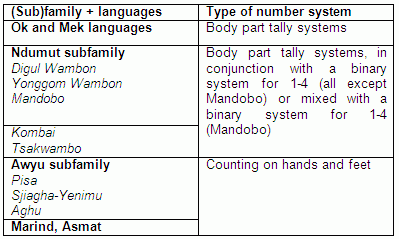
Body part tally systems of the Ndumut languages, Kombai and Tsakwambo
The Ndumut languages as well as Kombai and Tsakwambo have a type of body part tally system found all over New Guinea in many variations (Laycock 1975). Counting starts on the little finger of the left hand (number 1) which the speaker touches or bends with the middle finger or index finger of the right hand. Via ring finger (2), middle finger (3) and index finger (4) the speaker reaches the thumb (5) after which he climbs the left arm starting with the wrist (6), then lower arm (7), elbow (the inside is touched, (8)), upper arm (9) and shoulder (10).
Kombai uses just two points on the head and proceeds after the shoulder (10) to the left ear (11) and reaches the turning point in the crown of the head (12) after which the ear on the other side (13) is touched, followed by the shoul¬der of the other side (14) and so forth until the little finger of the right hand is reached (23). Wambon uses four points on the head: neck (11), ear (12), eye (13) and nose (14) and ends up in 27.
When after the turning point counting continues on the right side of the body, a prefix meaning 'other side' is used; although these languages know the distinction between 'left' and 'right', they do not use it in the counting system. As an example of body part tally systems the Kombai and Mandobo systems will be discussed.
The Kombai number system: body part in conjunction with binary system
The Kombai number system is a pure body-part system used in conjunction with a binary system comprising the 'true' numerals mofenadi 'one' and (mo)lumo 'two'. First the tally system:
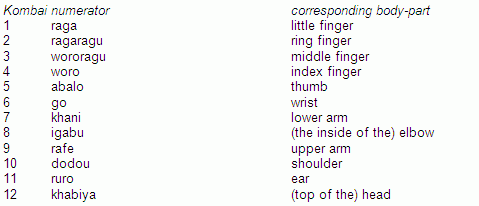
The head is the turning point after which the counting goes down again via the right-hand side of the body, by adding the word imofo 'other side' to the numbers:
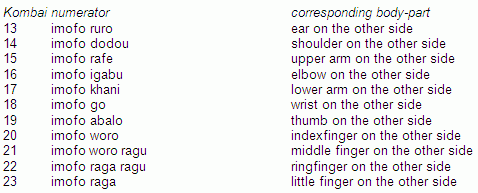
When the numbers function attributively in noun phrases, they take the attributive suffix -khu:

The suffix -khu basically means 'also', 'added':

The body part/numbers from little finger/1 to indexfinger/4 cannot be used to qualify nouns (thus one cannot say kho ragaragu-khu ‘two men’. They only function, first, in direct counting of objects ('one, two, three, four,..'), and, second, in compound nouns denoting days of the week and months of the year. For the first four numbers (1-4) Kombai has the following primitive number words and this binary 'true' numeral system is used to qualify nouns in noun phrases but never in direct counting:
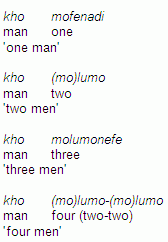
For attributive 'one' some speakers use the word mokhaliyo. The binary numerals 1-4 have the following internal structure:

The transitional nasal /n/ always occurs when vowels become adjacent in morpheme sequencing (cf. De Vries 1989). The use of an adverbial element meaning 'just', 'only' with the nume¬ral 1 has also also been reported for other Papuan languages (e.g. in Siroi of Papua New Guinea (Wells 1979: 22).
The Mandobo number system: body part system mixed with binary system
The Mandobo (or Kaeti) number system has been described by Drabbe (1959: 100) and Boelaars (1970). The system is a mixture of a binary system and a body-part tally system. It has basic number words for 'one' (ome) and 'two' (rumo). The status of the numeral ititmo 'three' is somewhat unclear. Drabbe (1959: 100) offers two possible analyses, one in which ititmo is a 'genuine' (not body part based) numeral and one in which it is body part numeral consisting of it 'hand' and a hypothetical element tit 'middle finger'.
For numbers higher than three, Mandobo uses body part terms. The 'real' numerals are integrated in the series of body part numbers (see e.g. the expressions for 22 and 23 where the expression for 'other side (of the body)' is used with the non-body-part numerals for 1 and 2).
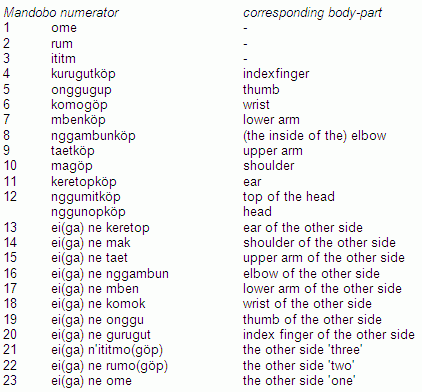
For 13-20 one can also use expressions in which the noun ei(ga) folllows the body-part noun, followed by göp 'also, added':

The word köp 'also, added' occurs also with the expressions for 4-12 and optionally with 21 and 22.
Counting on hands and feet in the Awyu languages
As all Awyu language exhibit counting on hands and feet, it suffices to describe the Aghu language as an illustration.
Aghu is spoken by about 2000 persons in the area between the Digul and the Mappi (see Map I at the end of this article) . The Aghu language was described by Drabbe (1957). The Yair Yair have quite many intermarriage relations with the Kombai and many Yair are bilingual Kombai-Yair speakers. I follow the account of the Aghu number system given by Drabbe (1957: 28).
The Aghu use hands and feets in counting, as follows:
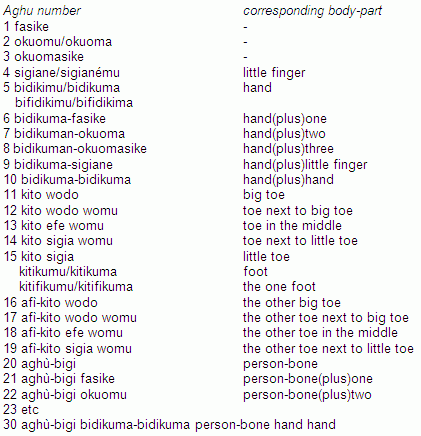
The highest point in the Aghu system is 30. When counting from 1 upwards the Aghu bend the fingers of the left hand first, starting with the thumb; when the ring finger is bent, the Aghu say sigiane 'little finger' because that is the only finger still sticking out. Thus the little finger corresponds to 4. Counting then proceeds to the fingers of the right hand. When these are bent, two hands ('ten') are counted.
The Aghu then descend to the big toe of the left foot ('eleven') and count on the toes of the left foot until one foot is counted ('fifteen'). Then they proceed to the foot on the other side, using a word for 'side, other side' to indicate the switch to the other side of the body. The word kito means 'foot'; it is used preceding names of the fingers to denote corresponding toes, thus wodo 'thumb', kito wodo 'big toe (thumb of the foot)/eleven'.
In the word for 20, aghu-bigi, aghu means 'man, person'. The word bigi 'bone' is often used to denote something in its whole length, e.g. kesaghe bigi 'tree, stem of tree'. With aghu 'man' in the context of counting it means 'the whole man, i.e. fingers and toes, i.e. 20'.
